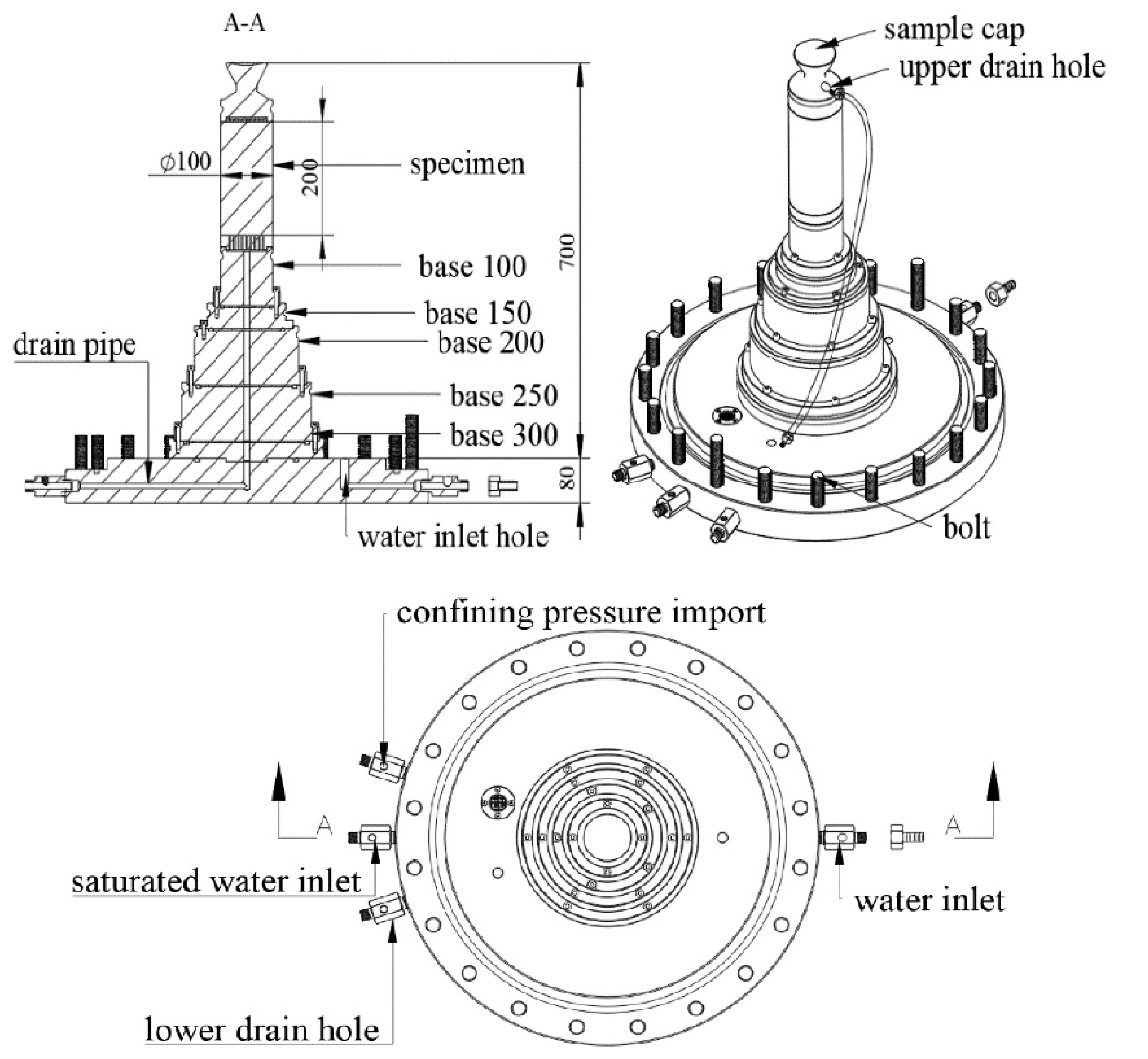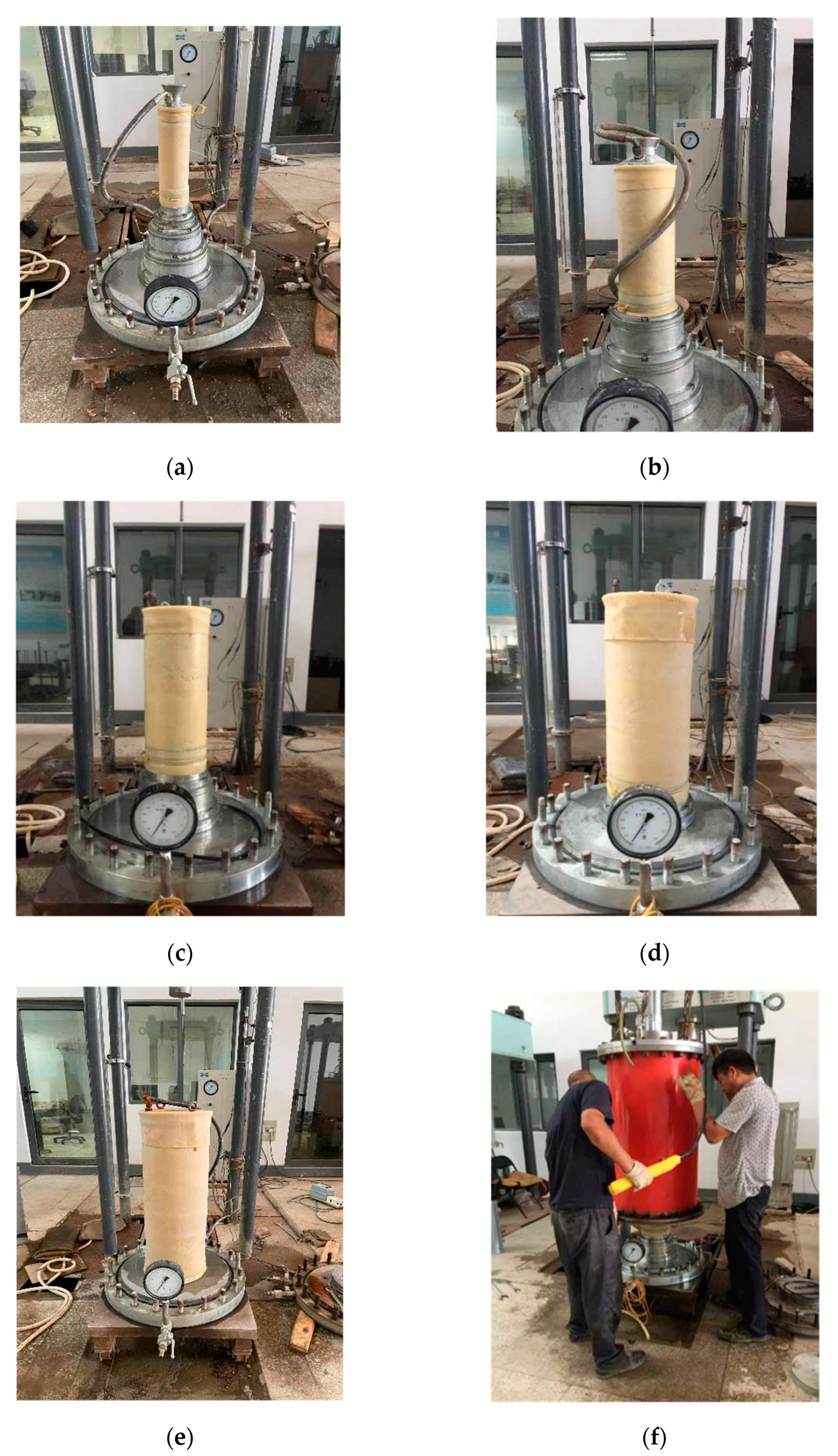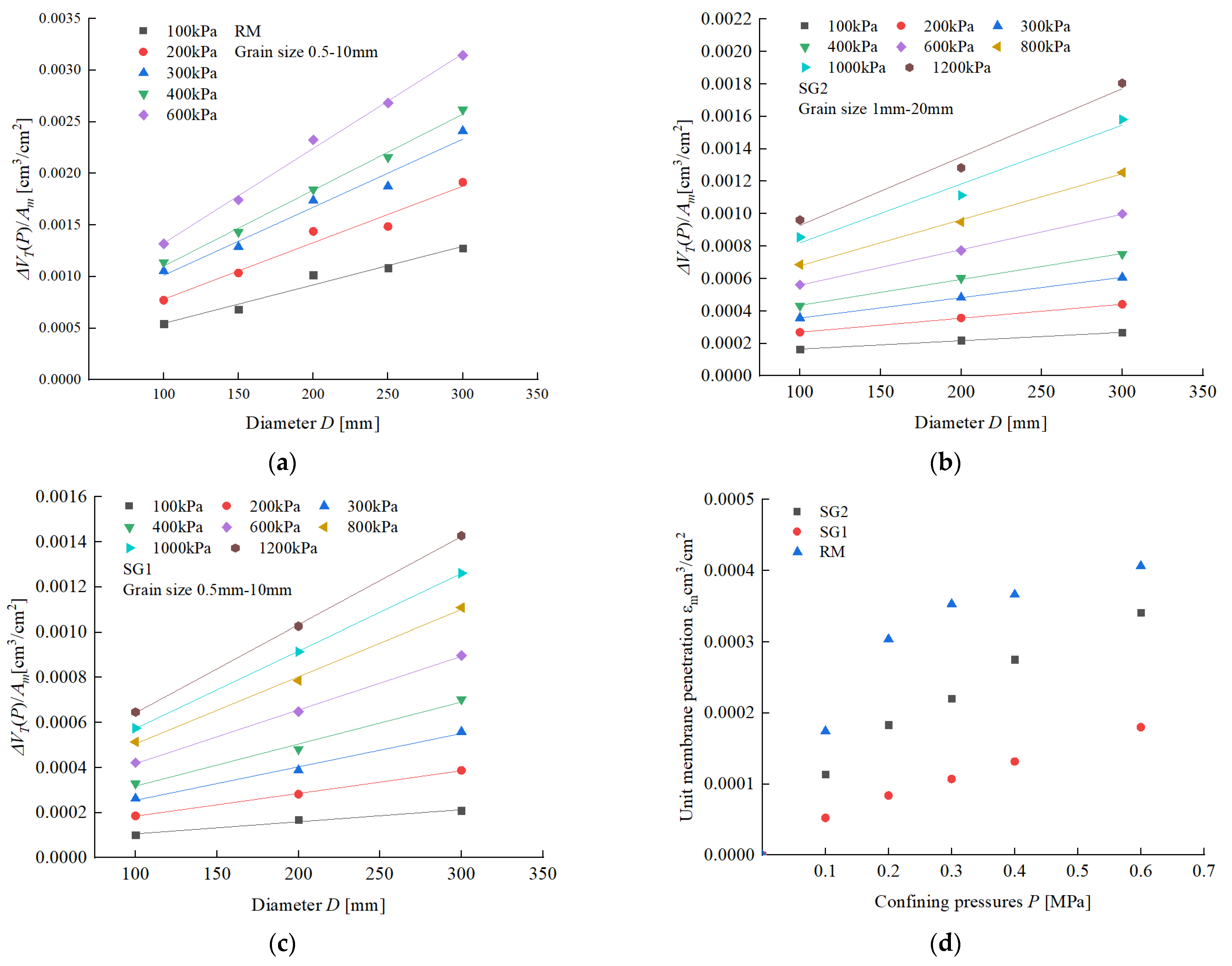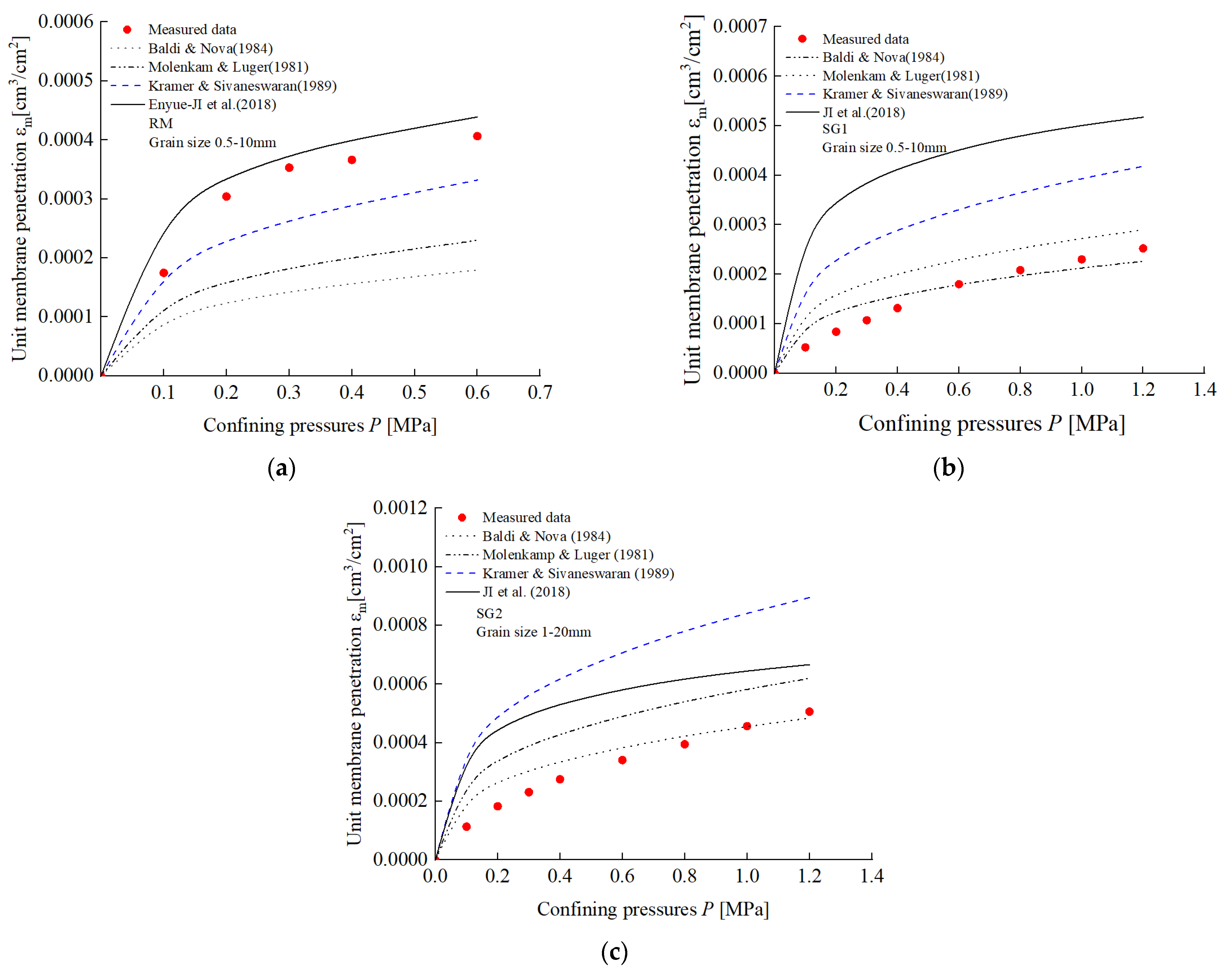A Novel Procedure to Measure Membrane Penetration of Coarse Granular Materials
Abstract
1. Introduction
2. Measurement of the Membrane Penetration: A Novel Procedure
2.1. Basic Principle
2.2. Chassis Apparatus of the Triaxial Test
3. Materials and Methods
3.1. Testing Material
3.2. Specimen Prepration
3.3. Test Results and Analysis
4. Discussion
4.1. Comparison with Previous Formulas
4.2. Comparison with Existing Experimental Procedures Addressing Rubber Membrane Penetration
5. Conclusions
- (1)
- The penetration effect of the rubber membrane should not be ignored. The ratio of the membrane penetration to the total volume change for rockfill materials ranged from 13.0% to 39.4%, while the penetration proportion of sandy gravel reached 69.4%. Compared with the small-sized triaxial test, the large-scale triaxial consolidation drainage test can reduce the penetration proportion of the membrane and should be recommended and promoted.
- (2)
- There is a great difference in the experimental results of the membrane penetration of rockfill materials and sandy gravel calculated by the former formula, and the former formula is not applicable to all materials. Therefore, the membrane penetration should be corrected by comprehensively considering the particle size and lithology of materials.
Author Contributions
Funding
Institutional Review Board Statement
Informed Consent Statement
Data Availability Statement
Conflicts of Interest
References
- De Beer, E.E. The cell test. Geotechnique 1950, 2, 162–172. [Google Scholar] [CrossRef]
- Sivathayalan, S.; Vaid, Y.P. Truly undrained response of granular soils with no membrane-penetration effects. Can. Geotech. J. 1998, 35, 730–739. [Google Scholar] [CrossRef]
- Newland, P.L.; Allely, B.H. Volume changes in drained taixial tests on granular materials. Geotechnique 1957, 7, 17–34. [Google Scholar] [CrossRef]
- Newland, P.L.; Allely, B.H. Volume changes during undrained triaxial tests on saturated dilatant granular materials. Geotechnique 1959, 9, 174–182. [Google Scholar] [CrossRef]
- EI-Sohby, M.A.; Andrawes, K.Z. Deformation Characteristics of Granular Material Under Hydrostatic Compression. Can. Geotech. J. 1972, 9, 338–350. [Google Scholar] [CrossRef]
- Vaid, Y.P.; Negussey, D. A Critical Assessment of Membrane Penetration in the Triaxial Test. Geotech. Test. J. 1984, 7, 70–76. [Google Scholar]
- Kramer, S.L.; Sivaneswaran, N. Stress-path-dependent correction for membrane penetration. J. Geotech. Eng. 1989, 115, 1787–1804. [Google Scholar] [CrossRef]
- Roscoe, K.H.; Schofield, A.N.; Thurairajah, A. An Evaluation of Test Data for Selecting a Yield Criterion for Soils. In Laboratory Shear Testing of Soils; ASTM International: West Conshohocken, PA, USA, 1964; pp. 111–128. [Google Scholar]
- Raju, V.S.; Sadasivan, S.K. Membrane Penetration in Triaxial Tests on Sands. J. Geotech. Eng. Div. 1974, 100, 482–489. [Google Scholar] [CrossRef]
- Ji, E.; Zhu, J.; Wang, Q.; Jiang, M. Experiment of membrane penetration on coarse grained soil. Chin. J. Geotech. Eng. 2018, 40, 346–352. [Google Scholar]
- Frydman, S.; Zeitlen, J.G.; Alpan, I. The membrane effect in triaxial testing of granular soils. J. Test. Eval. 1973, 1, 37–41. [Google Scholar]
- Kiekbush, M.; Schuppenner, B. Membrane Penetration and its Effects on Pore Pressures. J. Geotech. Eng. Div. 1977, 103, 1267–1280. [Google Scholar] [CrossRef]
- Bohac, J.; Feda, J. Membrane penetration in triaxial tests. Geotech. Test. J. 1992, 15, 288–294. [Google Scholar]
- Evans, M.D. Density changes during undrained loading—Membrane compliance. J. Geotech. Eng. 1992, 118, 1924–1936. [Google Scholar] [CrossRef]
- Nicholson, P.G.; Seed, R.B.; Anwar, H.A. Elimination of membrane compliance in undrained triaxial testing II. Mitigation by injection compensation. Can. Geotech J 1993, 30, 739–746. [Google Scholar] [CrossRef]
- Nicholson, P.G.; Seed, R.B.; Anwar, H.A. Elimination of membrane compliance in undrained triaxial testing. I. Measurement and evaluation. Can. Geotech. J. 1993, 30, 727–738. [Google Scholar] [CrossRef]
- Miura, S.; Kawamura, S. A procedure minimizing membrane penetration effects in undrained triaxial test. Soils Found. 1996, 36, 119–126. [Google Scholar] [CrossRef][Green Version]
- Noor, M.J.M.; Nyuin, J.D.; Derahman, A. A graphical method for membrane penetration in triaxial tests on granular soils. J. Inst. Eng. Malays. 2012, 73, 23–30. [Google Scholar]
- Lo, S.C.R.; Chu, J.; Lee, I.K. A technique for reducing membrane penetration and bedding errors. Geotech. Test. J. 1989, 12, 311–316. [Google Scholar]
- Tsoi, W.; Lee, K. Membrane Penetration Remedy for the Testing of Lightly Cemented Scrap Rubber Tire Chips. Geotech. Test. J. 2009, 32, 55–63. [Google Scholar]
- Choi, J.W.; Ishibashi, I. An Experimental Method for Determining Membrane Penetration. Geotech. Test. J. 1992, 15, 413–417. [Google Scholar]
- Raghunandan, M.E.; Sharma, J.S.; Pradhan, B. A review on the effect of rubber membrane in triaxial tests. Arab. J. Geosci. 2015, 8, 3195–3206. [Google Scholar] [CrossRef]
- Tokimatsu, K.; Nakamura, K. A Liquefaction Test without Membrane Penetration Effects. Soils Found. 1986, 26, 127–138. [Google Scholar] [CrossRef]
- Molenkamp, F.; Luger, H.J. Modelling and minimization of membrane penetration effects in tests on granular soils. Géotechnique 1981, 31, 471–486. [Google Scholar] [CrossRef]
- Baldi, G.; Nova, R. Membrane Penetration Effects in Triaxial Testing. J. Geotech. Eng. 1984, 110, 403–420. [Google Scholar] [CrossRef]
- Ji, E.; Zhu, J.; Wang, Q.; Chen, S.; Jin, W. Analytic solution and experimental study of membrane penetration in triaxial test. Geomech. Eng. 2018, 13, 1027–1044. [Google Scholar]








| Materials | Specific Gravity Gs | Initial Void Ratio e | d50 [mm] | ρd [g/cm3] |
|---|---|---|---|---|
| RM | 2.70 | 0.59 | 2.84 | 1.70 |
| SG1 | 2.69 | 0.51 | 2.84 | 1.78 |
| SG2 | 2.69 | 0.51 | 5.98 | 1.78 |
| RM | Diameter [mm] | ||||
|---|---|---|---|---|---|
| Confining Pressure (kPa) | 100 | 150 | 200 | 250 | 300 |
| 100 | 32.1 | 25.6 | 17.2 | 16.1 | 13.7 |
| 200 | 39.4 | 29.4 | 21.1 | 20.5 | 15.9 |
| 300 | 33.5 | 27.4 | 20.3 | 18.8 | 14.6 |
| 400 | 32.1 | 25.6 | 19.8 | 17.0 | 14.0 |
| 600 | 30.8 | 23.3 | 17.5 | 15.1 | 13.0 |
| SG | Diameter [mm] | |||||
|---|---|---|---|---|---|---|
| 100 | 200 | 300 | ||||
| Confining Pressure [kPa] | SG1 | SG2 | SG1 | SG2 | SG1 | SG2 |
| 100 | 51.6 | 69.4 | 31.2 | 51.8 | 25.1 | 42.6 |
| 200 | 45.1 | 68.2 | 29.7 | 51.4 | 21.6 | 41.6 |
| 300 | 40.8 | 64.9 | 27.6 | 47.9 | 19.2 | 38.1 |
| 400 | 40.0 | 63.8 | 27.3 | 45.7 | 18.8 | 36.7 |
| 600 | 42.7 | 60.7 | 27.8 | 44.1 | 20.1 | 34.1 |
| 800 | 40.5 | 57.6 | 26.5 | 41.7 | 18.8 | 31.5 |
| 1000 | 40.1 | 53.5 | 25.2 | 41.2 | 18.3 | 28.9 |
| 1200 | 39.1 | 52.7 | 24.6 | 39.6 | 17.7 | 28.1 |
Publisher’s Note: MDPI stays neutral with regard to jurisdictional claims in published maps and institutional affiliations. |
© 2022 by the authors. Licensee MDPI, Basel, Switzerland. This article is an open access article distributed under the terms and conditions of the Creative Commons Attribution (CC BY) license (https://creativecommons.org/licenses/by/4.0/).
Share and Cite
Xu, W.; Ji, E.; Shi, B.; Chen, C. A Novel Procedure to Measure Membrane Penetration of Coarse Granular Materials. Appl. Sci. 2022, 12, 6381. https://doi.org/10.3390/app12136381
Xu W, Ji E, Shi B, Chen C. A Novel Procedure to Measure Membrane Penetration of Coarse Granular Materials. Applied Sciences. 2022; 12(13):6381. https://doi.org/10.3390/app12136381
Chicago/Turabian StyleXu, Weiwei, Enyue Ji, Beixiao Shi, and Chenghao Chen. 2022. "A Novel Procedure to Measure Membrane Penetration of Coarse Granular Materials" Applied Sciences 12, no. 13: 6381. https://doi.org/10.3390/app12136381
APA StyleXu, W., Ji, E., Shi, B., & Chen, C. (2022). A Novel Procedure to Measure Membrane Penetration of Coarse Granular Materials. Applied Sciences, 12(13), 6381. https://doi.org/10.3390/app12136381






